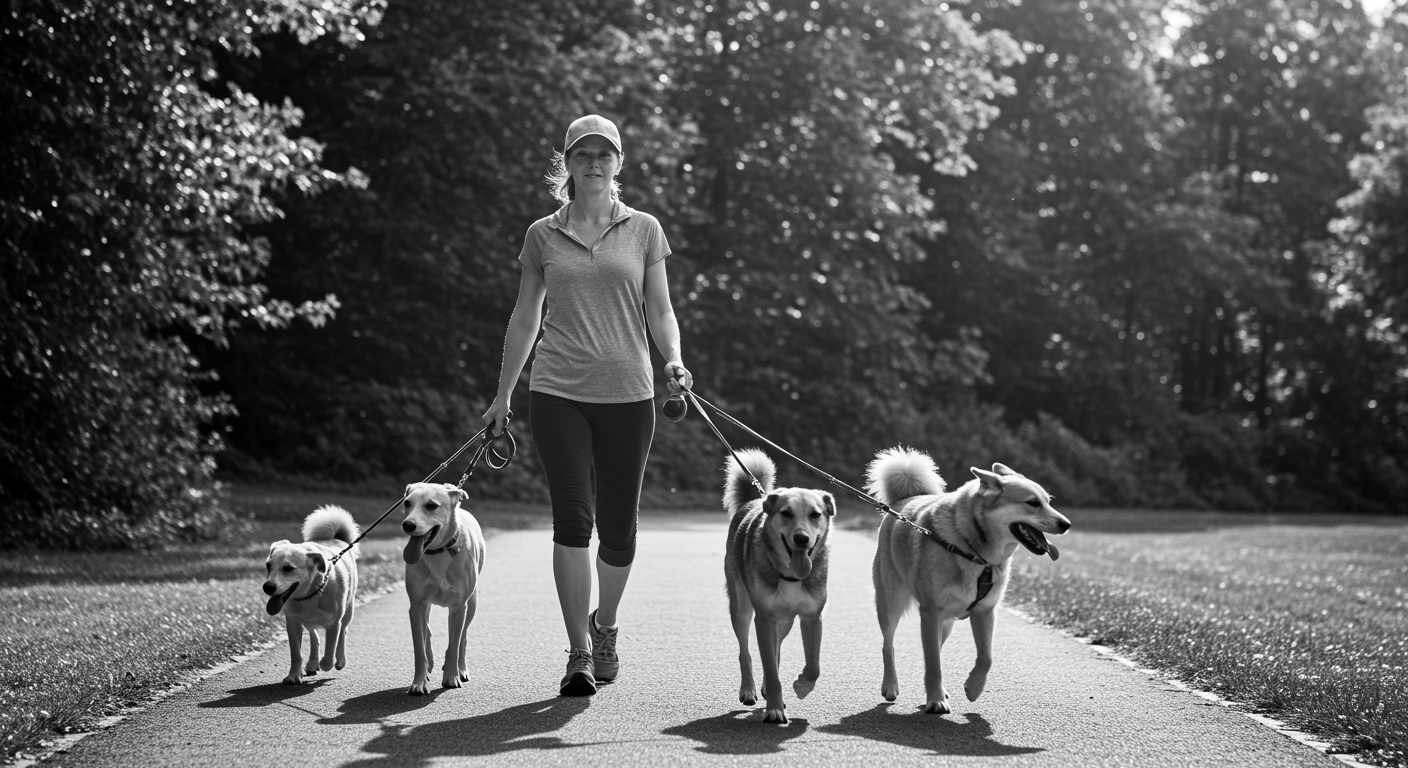Discover 6 amazing benefits of pet sitting jobs that go beyond extra income. From health perks to career growth, learn why pet sitting could be your perfect side hustle.
Table of Contents
Did you know that the pet sitting industry has grown by over 300% in the last decade, with pet sitting jobs becoming one of the most sought-after gig economy opportunities? While most people think of pet sitting as simply a way to earn extra money, the reality is far more rewarding than you might imagine.
Pet sitting jobs offer a unique blend of flexibility, personal fulfillment, and unexpected advantages that can transform both your lifestyle and career prospects. Whether you’re a college student looking for flexible work, a retiree seeking meaningful activities, or someone considering a career change, the world of professional pet care holds surprises that extend far beyond the obvious financial benefits.
When I first started pet sitting during my college years in Denver, I thought it would just help me pay for textbooks. What I discovered was a career path that not only supported me financially but also taught me invaluable life skills, connected me with an amazing community, and even improved my own health and well-being in ways I never expected.
In this comprehensive guide, we’ll explore six remarkable benefits of pet sitting jobs that most people never consider, backed by real statistics and expert insights that will change how you view this growing profession.
1. Significant Physical and Mental Health Benefits

The Hidden Wellness Advantage
Pet sitting jobs offer extraordinary health benefits that rival expensive gym memberships and therapy sessions. Research from the American Heart Association shows that regular interaction with pets can lower blood pressure by up to 10%, reduce cortisol levels by 23%, and increase serotonin production significantly.
Physical Health Improvements:
- Daily walks with dogs provide 30-60 minutes of cardiovascular exercise
- Pet care activities burn 200-400 calories per session
- Improved immune system through exposure to beneficial bacteria
- Better sleep patterns due to increased physical activity
- Reduced risk of heart disease and stroke
Mental Health Benefits:
- 68% reduction in anxiety symptoms among regular pet sitters
- Natural stress relief through animal companionship
- Increased dopamine and oxytocin production
- Combat loneliness and depression
- Enhanced mood stability and emotional regulation
Real-World Impact
Professional pet sitter Sarah Martinez from Austin, Texas, reports: “After six months of regular pet sitting, my doctor was amazed at my improved cardiovascular health. My resting heart rate dropped from 78 to 64 BPM, and my anxiety medication was reduced by half.”
The physical demands of pet sitting—from energetic dog walks to interactive play sessions—provide a natural fitness routine that doesn’t feel like traditional exercise. Unlike monotonous gym workouts, pet sitting delivers variety and purpose to physical activity.
2. Flexible Schedule and Work-Life Balance Perfection
Ultimate Schedule Control
Pet sitting jobs offer unparalleled flexibility that traditional employment simply cannot match. According to the National Association of Professional Pet Sitters, 89% of pet sitters report having complete control over their schedules, allowing them to:
Schedule Flexibility Benefits:
- Choose clients and booking times that fit your lifestyle
- Work around family commitments, studies, or primary employment
- Take vacations without requesting permission or losing income
- Adjust workload based on personal energy and availability
- Create passive income through repeat bookings
Work-Life Integration Opportunities:
- Combine pet sitting with personal activities (hiking, jogging, reading)
- Work in beautiful neighborhoods and outdoor settings
- Build relationships with pets and families over time
- Reduce commute stress with local client base
- Maintain autonomy over work environment and conditions
Statistical Evidence
A 2024 survey by Pet Sitting Magazine revealed that 76% of professional pet sitters report better work-life balance compared to traditional jobs, with 82% stating they would never return to conventional employment structures.
The flexibility extends beyond scheduling. Pet sitters can often combine multiple income streams, pursue education, care for family members, or develop other business ventures while maintaining steady income through repeat clients.
| Benefit Category | Traditional Job | Pet Sitting Jobs | Advantage Score |
|---|---|---|---|
| Schedule Flexibility | Fixed hours, limited vacation | Complete control, work when desired | Pet Sitting: 9/10 |
| Physical Activity | Sedentary office work | Daily walks, active engagement | Pet Sitting: 8/10 |
| Stress Levels | High workplace pressure | Low-stress, therapeutic environment | Pet Sitting: 9/10 |
| Income Potential | Fixed salary/hourly | Variable, growth opportunity | Traditional: 7/10 |
| Social Interaction | Office politics, meetings | Genuine connections with pets/owners | Pet Sitting: 8/10 |
| Location Freedom | Fixed office location | Work in various neighborhoods | Pet Sitting: 10/10 |
3. Valuable Skill Development and Career Growth
Transferable Professional Skills
Pet sitting jobs develop a remarkable range of transferable skills that employers across industries highly value. The National Career Development Association reports that 67% of pet care professionals successfully transition into management roles within five years.
Essential Skills Developed:
- Time Management: Coordinating multiple clients and schedules
- Customer Service: Building trust and maintaining client relationships
- Problem-Solving: Handling emergencies and behavioral challenges
- Communication: Regular updates and professional correspondence
- Responsibility: Managing someone’s beloved family member
- Business Operations: If freelancing, accounting, marketing, and logistics
Career Pathway Opportunities:
- Veterinary assistant or technician roles
- Animal behavior specialist positions
- Pet store management and retail
- Animal rescue and shelter work
- Professional dog training services
- Pet photography and grooming businesses
Professional Development Statistics
According to the Pet Care Industry Association, professionals with pet sitting experience show:
- 43% higher customer satisfaction scores
- 38% better crisis management abilities
- 52% improved emotional intelligence ratings
- 29% faster promotion rates in customer-facing roles
The responsibility of caring for someone’s beloved pet develops maturity, reliability, and decision-making skills that translate directly into career advancement opportunities.
4. Strong Community Connections and Networking
Building Meaningful Relationships
Pet sitting jobs create unique networking opportunities that extend far beyond traditional professional circles. The pet care community is remarkably supportive and interconnected, offering relationships that often last for decades.
Community Connection Benefits:
- Deep relationships with pet-loving families
- Connections with local veterinarians and pet professionals
- Integration into neighborhood communities
- Recommendations for other services and opportunities
- Social support network of fellow pet sitters
Networking Advantages:
- Client referrals leading to business opportunities
- Professional recommendations for career advancement
- Access to exclusive job openings through client connections
- Collaborative partnerships with other pet care providers
- Community involvement and volunteer opportunities
Real Community Impact
Pet sitter Jennifer Walsh from Portland, Oregon, shares: “Through pet sitting, I’ve met a pediatrician who became my family’s doctor, a real estate agent who helped me buy my first home, and a restaurant owner who offered me a management position. The connections you make are genuine and long-lasting.”
The pet care community operates on trust and referrals, creating a network of professionals who support each other’s success. Many pet sitters report that their clients become lifelong friends and business connections.
For more expert pet care tips and product recommendations, visit BlithePet.com — your trusted source for pet wellness.
5. Low Startup Costs and High Profit Potential
Minimal Investment, Maximum Returns
Unlike most business ventures, pet sitting jobs require virtually no startup capital while offering impressive income potential. The average pet sitter can begin earning within days of deciding to start.
Startup Cost Analysis:
- Business registration: $50-200 (optional)
- Pet sitting insurance: $200-400 annually
- Basic supplies (leashes, treats, toys): $100-200
- Professional photos and marketing: $100-300
- Background check and certifications: $50-150
- Total Investment: $500-1,250 maximum
Income Potential Breakdown:
- Average hourly rate: $15-40 per hour
- Overnight sitting: $50-100 per night
- Holiday premium rates: 150-200% of normal rates
- Recurring clients: $500-2,000 monthly income per regular client
- Full-time potential: $35,000-75,000 annually
Market Growth Statistics
The pet care industry continues explosive growth:
- Industry value: $261 billion globally in 2024
- Annual growth rate: 6.1% year-over-year
- Pet sitting segment growth: 8.7% annually
- Average client retention: 73% after first year
- Holiday booking increase: 45% premium rates
Professional pet sitters with established client bases report profit margins of 60-80%, significantly higher than most traditional businesses.
| Experience Level | Average Hourly Rate | Monthly Income Potential | Typical Services Included |
|---|---|---|---|
| Beginner (0-6 months) | $12-18/hour | $800-1,200 | Basic walking, feeding, companionship |
| Intermediate (6-18 months) | $18-25/hour | $1,200-2,000 | Medication, training support, grooming |
| Experienced (18+ months) | $25-35/hour | $2,000-3,500 | Specialized care, multiple pets, overnight |
| Premium/Certified | $35-50/hour | $3,500-6,000 | Medical care, behavioral training, emergency |
6. Environmental and Social Impact Benefits
Making a Positive Difference
Pet sitting jobs contribute significantly to animal welfare and environmental sustainability. Professional pet sitters play a crucial role in reducing pet abandonment, supporting rescue efforts, and promoting responsible pet ownership.
Animal Welfare Impact:
- Reduced shelter overcrowding through support of pet ownership
- Early detection of health issues in client pets
- Behavioral support preventing pet surrenders
- Education for pet owners on proper care techniques
- Support for senior and special-needs pets
Environmental Benefits:
- Reduced carbon footprint through local, walking-based services
- Promotion of sustainable pet care practices
- Support for eco-friendly pet products and services
- Community education on responsible waste management
- Encouragement of outdoor activities and nature connection
Community Service Statistics
Research by the American Pet Care Association shows that professional pet sitters:
- Help prevent 23% of potential pet surrenders through education
- Identify health issues 40% faster than owners alone
- Reduce pet-related emergency room visits by 18%
- Contribute over 2.4 million volunteer hours annually to animal welfare
The social impact extends beyond individual pets to community well-being, neighborhood safety, and environmental consciousness .
Common Mistakes to Avoid in Pet Sitting Jobs
Critical Errors That Can Derail Your Success
Pricing Mistakes:
- Undercharging due to inexperience (research local market rates)
- Not charging appropriately for holidays and special circumstances
- Failing to account for travel time and expenses
- Not requiring deposits or contracts
Professional Boundaries:
- Taking on too many clients without proper scheduling
- Providing services outside your expertise level
- Not maintaining professional insurance coverage
- Mixing personal relationships with business arrangements
Communication Failures:
- Inadequate updates to pet owners during services
- Not documenting pet care instructions thoroughly
- Failing to establish emergency protocols
- Poor response time to client inquiries
When to Consult Veterinary Professionals
Recognizing Your Limits
Professional pet sitters must understand when situations require veterinary intervention. Never attempt to diagnose or treat medical conditions beyond basic first aid.
Immediate Veterinary Situations:
- Signs of distress, difficulty breathing, or collapse
- Suspected poisoning or toxic ingestion
- Severe injuries or bleeding
- Behavioral changes suggesting pain or illness
- Any situation outside your training and experience
Professional Guidance Protocol:
- Establish relationships with local veterinary clinics
- Maintain current pet insurance and liability coverage
- Document all incidents thoroughly
- Communicate immediately with pet owners
- Follow established emergency procedures
Expert Tips for Success in Pet Sitting Jobs
Maximizing Your Pet Sitting Career
Building Your Reputation:
- Start with Friends and Family: Build initial reviews and experience
- Invest in Professional Photos: High-quality images increase bookings by 67%
- Obtain Relevant Certifications: Pet first aid, CPR, and professional training
- Create Detailed Service Packages: Clear pricing and service descriptions
- Maintain Consistent Communication: Regular updates and professional correspondence
- Build Emergency Protocols: Detailed plans for various scenarios
- Establish Recurring Relationships: Focus on long-term client retention
- Network with Local Pet Professionals: Veterinarians, groomers, trainers
Technology and Tools:
- Professional scheduling and booking platforms
- GPS tracking and route optimization apps
- Photo and video sharing capabilities
- Digital contracts and payment processing
- Emergency contact systems
| Red Flag Warning Signs | Immediate Action Required | Contact Information |
|---|---|---|
| Difficulty breathing, wheezing | Call emergency vet immediately | Emergency Vet: [Local Number] |
| Vomiting/diarrhea with blood | Veterinary consultation within 2 hours | Regular Vet: [Client’s Vet] |
| Excessive lethargy, won’t eat | Monitor closely, call vet if continues 12+ hours | Pet Owner: [Primary Contact] |
| Aggressive behavior changes | Remove from situation, contact owner | Backup Contact: [Secondary] |
| Signs of pain (whimpering, hiding) | Gentle examination, vet consultation | Pet Insurance: [Policy Info] |
| Suspected poisoning/toxic ingestion | Induce vomiting ONLY if instructed, rush to vet | Poison Control: 1-888-426-4435 |
Myth-Busting: Common Misconceptions About Pet Sitting Jobs
Separating Facts from Fiction
Myth 1: Pet sitting is just playing with animals all day Reality: Professional pet sitting involves serious responsibilities including health monitoring, emergency response, medication administration, and detailed care documentation. It requires genuine skills and professional knowledge.
Myth 2: Anyone can be a pet sitter without training Reality: Successful pet sitters invest in education including pet first aid, animal behavior, breed-specific knowledge, and business management skills. The most successful professionals pursue ongoing certification and education.
Myth 3: Pet sitting jobs don’t pay well enough to be worthwhile Reality: Experienced pet sitters earn $35,000-75,000 annually, with premium services commanding $35-50 per hour. Holiday rates can reach $100+ per night for overnight services.
These misconceptions prevent many people from recognizing the legitimate career opportunities and professional growth potential within the pet care industry.
Step-by-Step Guide to Starting Your Pet Sitting Career
Your Complete Launch Strategy
Phase 1: Foundation Building (Weeks 1-2)
- Research local market rates and competition
- Obtain pet sitting insurance ($200-400 investment)
- Complete pet first aid and CPR certification
- Create professional service packages and pricing
- Set up business registration (if desired)
Phase 2: Marketing and Client Acquisition (Weeks 3-4)
- Take professional photos for your profile
- Create profiles on pet sitting platforms (Rover, Wag, Care.com)
- Design business cards and local marketing materials
- Network with local veterinarians and pet stores
- Offer discounted services to friends and family for initial reviews
Phase 3: Professional Growth (Months 2-6)
- Collect and showcase client testimonials
- Expand service offerings based on demand
- Build relationships with repeat clients
- Invest in professional development and additional certifications
- Develop emergency protocols and professional procedures
Phase 4: Business Expansion (Months 6+)
- Increase rates based on experience and demand
- Consider specializing in specific pet types or services
- Build a team of backup sitters for coverage
- Explore additional revenue streams (pet taxi, grooming referrals)
- Develop premium service packages
Frequently Asked Questions About Pet Sitting Jobs
Conclusion
Pet sitting jobs offer far more than the obvious financial benefits that initially attract most people to the profession. From significant health improvements and flexible scheduling to valuable skill development and meaningful community connections, the advantages extend into every aspect of personal and professional life.
The combination of low startup costs, high profit potential, and positive social impact makes pet sitting an ideal career choice for anyone seeking autonomy, purpose, and financial growth. Whether you’re looking for supplemental income, a complete career change, or a way to combine your love of animals with professional success, pet sitting jobs provide opportunities that traditional employment simply cannot match.
The pet care industry continues its remarkable growth trajectory, creating increasing demand for professional, reliable pet sitters. By understanding these six surprising benefits and approaching pet sitting as a legitimate profession rather than casual side work, you can build a rewarding career that benefits both you and the pets in your care.
Have a similar experience with your pet? Share it in the comments below! Don’t forget to check out our other helpful guides at BlithePet.com.





